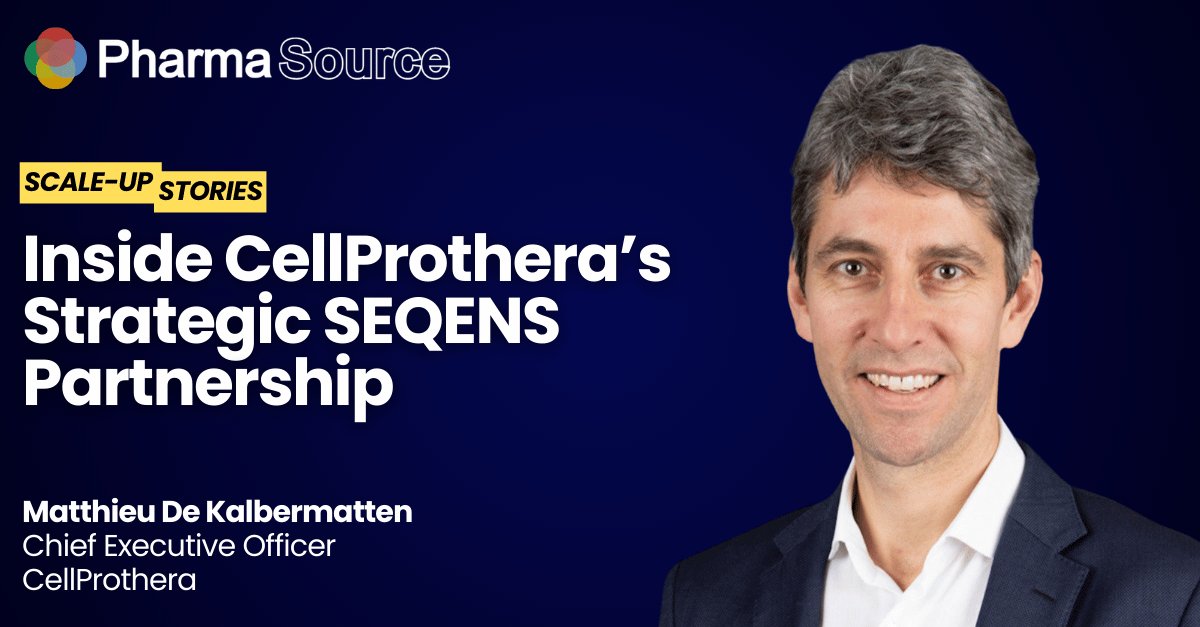“There are not that many European CDMOs with commercial expertise in cell therapy – who understand the regulatory requirements and production challenges when you have to manufacture large quantities on a regular basis. This is why we ended up with a very short list of two or three potential suppliers.”
CellProthera’s recent announcement of its manufacturing partnership with SEQENS for Phase III trials marks a pivotal moment in the French biotech’s journey from research lab to commercial reality. The eight-month technology transfer process now underway represents years of strategic planning and hard-won lessons about scaling cell therapy manufacturing.
In an exclusive interview, Matthieu De Kalbermatten, CEO of CellProthera, reveals the detailed selection process that led to choosing CELLforCURE by SEQENS as their manufacturing partner. His insights offer a rare glimpse into how biotechs navigate the complex transition from early development to commercial-scale production.
The Partnership Decision: Why Commercial Expertise Trumped Development Capabilities
CellProthera’s CDMO selection process revealed a stark reality about the cell therapy manufacturing landscape. When the company began evaluating potential partners for their cardiac regeneration therapy, they discovered that commercial manufacturing expertise dramatically narrows the field of qualified candidates.
“One of the criteria was to find a partner that would be able to work with us after Phase III in commercialisation,” Matthieu explains. “For this, you end up having a lot less offers on the table.”
The distinction proved crucial. While many organisations can support early-stage cell therapy development, few possess the infrastructure, regulatory knowledge, and operational experience required for commercial-scale production.
CellProthera’s rigorous analysis of European CDMOs yielded just two qualified finalists capable of supporting both Phase III trials and eventual commercialisation. This stringent approach, whilst limiting options, ensured the chosen partner possessed the necessary capabilities for long-term success.
SEQENS’ Commercial Track Record Proved Decisive
The final selection came down to proven commercial experience in cell therapy manufacturing. SEQENS’ CELLforCURE division brought unique credentials from their operational history under Novartis, where they successfully managed commercial-scale CAR-T production.
“We decided to go for CELLforCURE by SEQENS. This group has been fully operational on a commercial setting for CAR-T when they were under Novartis,” Matthieu explains. “They have very strong expertise in full production from storage to delivery that is super reliable with the best state-of-the-art equipment, and they were very competitive.”
The partnership wasn’t influenced by geographic proximity, despite both companies being French. “It’s not because we wanted to stay in France – the other candidates were in Europe, so they were quite easy to access too,” Matthieu clarifies.
However, Paris does provide strategic advantages for CellProthera’s planned European-scale Phase III trial. “Paris is a very good hub to connect to different places in Europe. We want to have a European-scale Phase III and deliver the product in various countries. It’s important to be well positioned in a good hub with transport options.”
Eight-Month Tech Transfer: Learning from Past Mistakes
The current eight-month technology transfer process between CellProthera and SEQENS reflects hard-won lessons from the biotech’s previous manufacturing experiences. Matthieu candidly shares how rushing earlier tech transfers across Europe and Asia taught valuable lessons about preparation and patience.
“We’re taking more time than one would think in this preparation phase, because we anticipate that you may end up having quality issues and misunderstanding,” Matthieu explains. “We experienced this before when we were opening tech transfer in three different locations in Europe and Asia. We wanted to be fast.”
The company’s previous approach of prioritising speed over thorough preparation created more problems than it solved. “We wanted to be quick, but this is not something you do within a few days. If you go too fast, you end up with disappointment, and you lose even more time.”
CellProthera’s current methodology involves extensive upfront investment in documentation alignment and team training. This approach directly addresses industry-wide challenges, as recent research from CDMO Live 2025 shows approximately 50% of tech transfers experience quality problems.
“The key is to accept spending more time at the preparation stage to make sure everything is well designed, defined, and ensure superb teamwork between both teams so you anticipate all the potential risks,” Matthieu reflects.
The collaborative approach will be critical for their European Phase III trial, which requires coordination across multiple countries and diverse regulatory environments. “The contractual side has to be well done. That’s why it’s important to have an experienced partner who knows what could happen and how we should deal with those things when they happen,” Matthieu explains.
The Science Behind CellProthera’s Cardiac Therapy
CellProthera’s ProtheraCytes® therapy represents a novel approach to treating severe heart attacks through cardiac tissue regeneration. The therapy utilises CD34-positive stem cells that have shown particular promise for restoring damaged heart tissue.
“CD34-positive cells are most adapted for the regeneration of heart tissues, and they have very strong power in revascularisation,” Matthieu explains. Unlike treatments that simply manage symptoms, CellProthera aims to actually regenerate damaged tissue.
The therapy addresses a critical timing window that many treatments miss. “If you have advanced heart failure patients two or three years after a heart attack, the lesion has been replaced by a fibrotic patch, and there is no real signal sent to the cells you’re going to inject. You really have to be quick.”
CellProthera targets patients shortly after heart attacks when multiple signals are still actively attracting the stem cells to the lesion. The treatment process spans approximately 15 days from initial patient selection to final injection, with a critical 9-day production phase using the company’s automated system.
Manufacturing Innovation: The StemXpand® Automation Solution
CellProthera has invested heavily in developing manufacturing technology to address fundamental scalability challenges in cell therapy. Their StemXpand® automated bioproduction system represents years of development through strategic collaborations.
“We are biologists, and we have a lab, but we don’t have industrial infrastructure to build a machine,” Matthieu explains. “That’s why we’ve been managing projects with several different partners who provide mechanic infrastructure and software engineering.”
The system, developed with support from French and European grants, operates autonomously for approximately nine days using disposable kits for each patient. This addresses key challenges in autologous cell therapy manufacturing.
“Cell therapy often struggles with being a very manual process, making it hard to scale. This system works with automated devices and disposable kits – for each patient, we use one kit,” Matthieu notes.
However, CellProthera learned important lessons about balancing automation with flexibility during development. The company discovered significant differences between their laboratory process, optimised for healthy donor cells, and clinical reality.
“The whole process was developed based on blood collection from healthy donors – 25-year-old very healthy people. Then you start your clinical phase, and you have mainly 60-plus year old patients with comorbidities, plus severe heart failure, and the cells do not react the same way.”
This experience shaped their automation philosophy. “You should not have a fully automated system during the development process, because there’s always some change that you may expect between Phase I and Phase II, or Phase II and Phase III.”
Navigating Investment Challenges in Cell Therapy
The cell therapy sector faces ongoing funding challenges that affect how biotechs approach manufacturing partnerships. Matthieu maintains optimism about securing investment for truly innovative treatments.
“The last few years have been tough for some geopolitical reasons, and nothing much related to the success or failure of cell and gene therapy in general. But there is money around. There are people, investors, who want to invest,” he observes.
The key lies in demonstrating transformative potential rather than incremental improvements. “I can’t think of anything better in terms of the underlying aim. You would find people enthusiastic about bringing something really new to patients in need, and there are still a lot of unmet medical needs.”
For biotech leaders facing similar challenges, Matthieu emphasises seeking expert guidance. “There’s a lot of expertise around the world. There are experts and consultants who have been through this type of issue. It’s much better to pick up this information quickly instead of redoing the same mistakes.”
He also stresses the importance of early commercial planning. “Biotechs sometimes think mainly about clinical development, clinical trials, and not so much about the industrialisation of their product later on. If you wait too long before thinking about automation, about having a system that is reliable and economically sustainable, you may end up at the end of Phase II with a product that works, but it’s just not possible to sell.”
Cell Therapy’s Commercial Future
Cost reduction remains a fundamental challenge for the broader cell therapy industry. “We have to work on production costs. The cost of those therapies is still high. As soon as we’ll have a few products in the market, bigger quantities being commercialised, then you will be able to have larger scale production of these raw materials.”
The autologous nature of cell therapy provides inherent advantages that could accelerate adoption once cost barriers are addressed. “This autologous therapy – you inject your own cells. You have no side effects. It’s absolutely safe. There’s no need for any immunosuppressive drugs that have all the side effects.”
Matthieu remains optimistic about cell therapy’s potential to transform medicine. “The promises of the science are so great. If we can prove the first one or two cell therapies can be commercially viable and make good money without having to be millions per dose, then investment will follow.”







